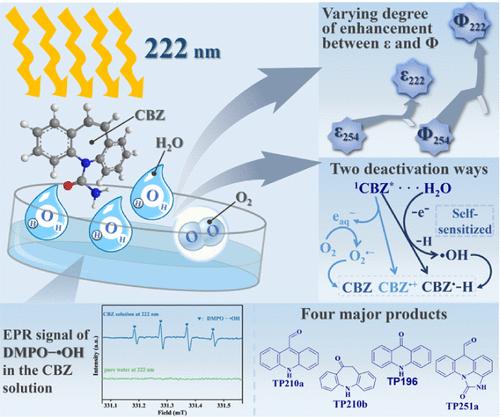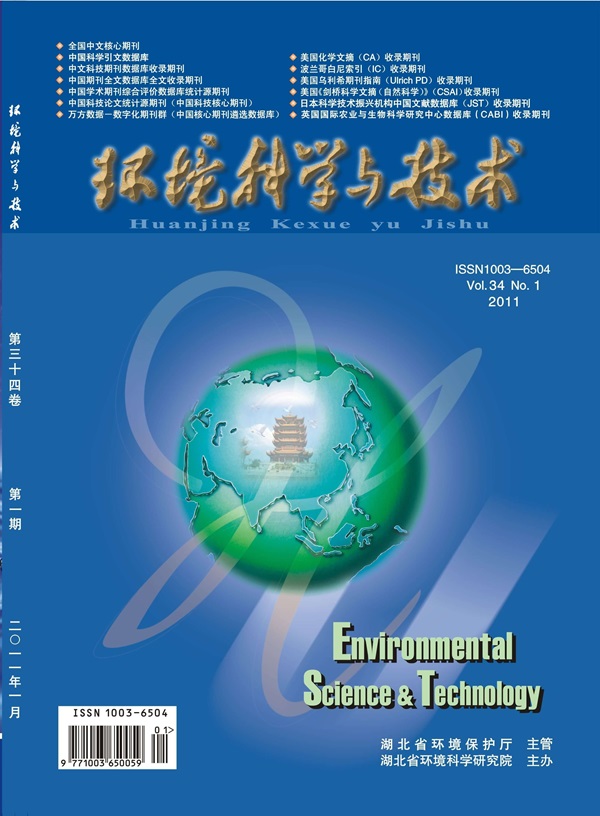Reactive Oxygen Species Generated in Situ During Carbamazepine Photodegradation at 222 nm Far-UVC: Unexpected Role of H2O Molecules
IF 10.8
1区 环境科学与生态学
Q1 ENGINEERING, ENVIRONMENTAL
引用次数: 0
Abstract
When 222 nm far-UVC is used to drive AOPs, photolysis emerges as a critical pathway for the degradation of numerous organic micropollutants (OMPs). However, the photodegradation mechanisms of the asymmetrically polarized OMPs at 222 nm remain unclear, potentially posing a knowledge barrier to the applications of far-UVC. This study selected carbamazepine (CBZ), a prevalent aquatic antiepileptic drug that degrades negligibly at 254 nm, to investigate its photodegradation mechanisms at 222 nm. Accelerated CBZ treatment by 222 nm far-UVC was mainly attributed to in situ ROS generation via self-sensitized photodegradation of CBZ. By quenching experiments and EPR tests, •OH radicals were identified as the major contributor to the CBZ photodegradation, whereas O2•– played a minor role. By deoxygenation and solvent exchange experiments, the H2O molecules were demonstrated to play a crucial role in deactivating the excited singlet state of CBZ (1CBZ*) at 222 nm: generating •OH radicals via electron transfer interactions with 1CBZ*. In addition, 1CBZ* could also undergo a photoionization process. The transformation products and pathways of CBZ at 222 nm were proposed, and the toxicities of CBZ’s products were predicted. These findings provide valuable insights into OMPs’ photolysis with 222 nm far-UVC, revealing more mechanistic details for far-UVC-driven systems.

222 纳米远紫外光在卡马西平光降解过程中原位生成的活性氧:H2O 分子的意外作用
当 222 纳米远紫外用于驱动 AOPs 时,光解成为降解多种有机微污染物(OMPs)的关键途径。然而,在 222 纳米波长下不对称极化的 OMPs 的光降解机制仍不清楚,这可能会对远紫外的应用造成知识障碍。本研究选择了在 254 纳米波长下降解微乎其微的水生抗癫痫药物卡马西平(CBZ),研究其在 222 纳米波长下的光降解机制。CBZ 在 222 纳米远紫外光下的加速处理主要是由于 CBZ 的自敏化光降解在原位产生了 ROS。通过淬灭实验和 EPR 测试,发现-OH 自由基是导致 CBZ 光降解的主要因素,而 O2 则起次要作用。通过脱氧和溶剂交换实验,证明了 H2O 分子在 222 纳米波长处的 CBZ 激发单线态(1CBZ*)失活过程中发挥了关键作用:通过与 1CBZ* 的电子转移相互作用产生 -OH 自由基。此外,1CBZ* 还可能发生光离子化过程。提出了 CBZ 在 222 纳米波长下的转化产物和途径,并预测了 CBZ 产物的毒性。这些发现为 OMPs 在 222 纳米远紫外光下的光解提供了宝贵的见解,揭示了远紫外光驱动系统的更多机理细节。
本文章由计算机程序翻译,如有差异,请以英文原文为准。
求助全文
约1分钟内获得全文
求助全文
来源期刊

环境科学与技术
环境科学-工程:环境
CiteScore
17.50
自引率
9.60%
发文量
12359
审稿时长
2.8 months
期刊介绍:
Environmental Science & Technology (ES&T) is a co-sponsored academic and technical magazine by the Hubei Provincial Environmental Protection Bureau and the Hubei Provincial Academy of Environmental Sciences.
Environmental Science & Technology (ES&T) holds the status of Chinese core journals, scientific papers source journals of China, Chinese Science Citation Database source journals, and Chinese Academic Journal Comprehensive Evaluation Database source journals. This publication focuses on the academic field of environmental protection, featuring articles related to environmental protection and technical advancements.
 求助内容:
求助内容: 应助结果提醒方式:
应助结果提醒方式:


